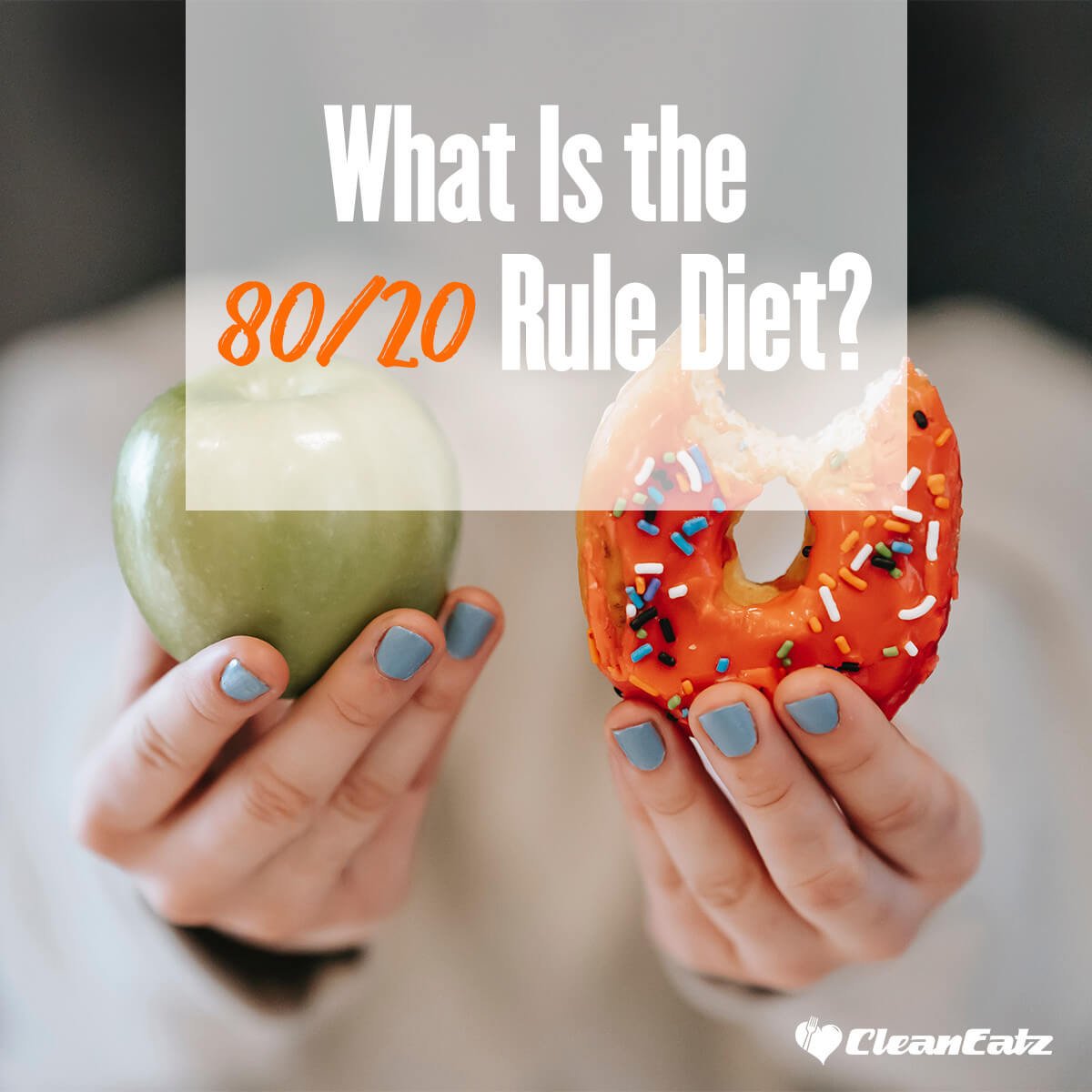If you've ever tried to follow the 80/20 rule diet or a healthy eating plan, you'll know how challenging it can be to stick to it 100% of the time. What is the 80/20 rule diet? It recognizes that achieving perfection for many people is unrealistic and unsustainable in the long term. Instead, the 80/20 rule diet promotes a balanced and flexible approach to healthy eating that allows you to enjoy your favorite foods in moderation while still achieving your health and nutrition goals.
What Is the 80/20 Rule Diet?
The 80/20 rule diet, also known as the Pareto principle, is a flexible approach to healthy eating that focuses on balance rather than strict rules or restrictions. What is the 80/20 rule diet? It suggests that 80% of your diet should consist of nutrient-dense, whole foods, while the remaining 20% can be allocated to indulgences or treats.
The idea behind the 80/20 rule diet is that eating healthily most of the time will provide your body with the nutrients it needs to function at its best. It's not so much a formal diet plan as a food philosophy that encourages balance and moderation.
How Does the 80/20 Rule Diet Work?
Long-term weight loss can be difficult, and many people find it challenging to stick to a strict diet for extended periods. Hence, this is where the 80/20 rule diet, also known as the Pareto principle, comes in – it is a flexible and balanced approach to healthy eating that encourages followers to adhere to the 80/20 rule diet by eating well 80% of the time while allowing for some indulgences for the remaining 20%.
What is the 80/20 rule diet? It is a concept that suggests dedicating 80% of your diet to nutrient-dense, whole foods and allocating the remaining 20% to occasional treats or indulgences.
However, allowing yourself the occasional treat or indulgence in the context of the 80/20 rule diet can help you stick to the plan in the long term and prevent feelings of deprivation or frustration. The 80/20 rule diet is not about strict rules or restrictions but rather a food philosophy that promotes balance and moderation for sustainable healthy eating.
What Are the Benefits of the 80/20 Rule Diet?
The 80/20 rule diet is a flexible approach to healthy eating that can offer a range of benefits for both physical and mental health. Here are some of the key benefits of following the 80/20 rule diet:
- It encourages a balanced and sustainable diet.
- It promotes a positive relationship with food.
- It helps prevent binge eating and cravings.
- It supports weight management.
- It provides a range of essential nutrients.
What foods are included in the 80/20 diet?
The basic premise of the 80/20 rule diet is simple: eat healthily 80% of the time and enjoy your favorite foods in moderation for the remaining 20%. What is the 80/20 rule diet, you may ask? It means that most of your meals and snacks should be based on nutrient-dense foods such as fruits, vegetables, whole grains, lean proteins, and healthy fats.
To follow the 80/20 rule diet, you'll need to adopt a healthy eating plan that's tailored to your individual nutritional needs and goals. This may involve consulting with a registered dietitian or nutritionist to create a personalized meal plan that meets your requirements. Embracing the 80/20 rule diet can help you strike a balance between nourishing your body with wholesome foods and enjoying occasional treats guilt-free.
In general, however, the 80/20 rule diet encourages you to:
Eat Fruits and Vegetables
To achieve a balanced and healthy diet following the 80/20 rule, it is recommended to incorporate a variety of fruits and vegetables into your daily meals. Aim to have at least five servings of colorful fruits and vegetables each day. Doing so ensures that you obtain a diverse array of vitamins, minerals, and phytonutrients that are essential for promoting good health. By embracing this approach, you can nourish your body with the nutrients it needs while still allowing yourself to enjoy your favorite foods in moderation.
Choose Whole Grains
When following the 80/20 rule diet, it's recommended to choose whole grains like brown rice, quinoa, and whole-wheat bread over refined grains such as white bread and pasta. The 80/20 rule diet emphasizes consuming predominantly wholesome foods, like whole grains, which are packed with fiber, vitamins, and minerals to keep you satiated for extended periods. Wondering what is the 80/20 rule diet? It's a dietary approach where 80% of your food choices consist of nutrient-dense options, like whole grains, while the remaining 20% can be more flexible to allow for occasional indulgences.
Include Lean Proteins
It's important to include lean protein sources in your 80/20 rule diet, such as chicken, fish, tofu, and legumes. These foods provide essential nutrients for building and repairing muscles, maintaining a healthy immune system, and keeping you feeling satisfied after meals. So, what is the 80/20 rule diet? It is a dietary approach where 80% of your food choices focus on nutritious options like the mentioned lean protein sources, while allowing 20% for occasional indulgences or treats. This balance ensures you get the most out of your diet while still enjoying the foods you love in moderation.
Incorporate Healthy Fats
On the other hand, in the 80/20 rule diet, it is advisable to limit the consumption of red meat and processed meats. These foods are often high in saturated fats, which can increase the risk of heart disease. By following the 80/20 rule, you can strike a balance between nutritious choices rich in healthy fats and occasional indulgences, ensuring a well-rounded and satisfying diet.
What Foods Are Excluded In the 80/20 Diet?
The 80/20 rule diet is a flexible eating approach that doesn't impose specific restrictions on foods. What is the 80/20 rule diet? Well, it means that you can enjoy a wide variety of foods, but it's crucial to consider the quality and quantity of your choices to maintain overall health and nutrition.
For instance, as part of your 20%, you might decide to indulge in a slice of cake or a bag of chips, but it's still essential to be mindful of portion sizes and the overall nutrient content in your diet.
It's worth noting that some foods may have less beneficial impacts on your overall health and nutrition. Foods high in saturated and trans fats, like fried foods and processed meats, should be limited in a healthy diet.
Although foods such as candy, chips, and sugary drinks are not off-limits on the 80/20 rule diet, consuming them in large amounts may not provide many nutrients and could contribute to weight gain and other health issues.
Remember, while the 80/20 rule diet allows for occasional treats, maintaining a balanced diet is key, and focusing on whole, nutrient-dense sources for most of your food choices will help support your overall well-being.
How to Implement the 80/20 Rule Diet
Implementing the 80/20 rule diet can be an effective and sustainable way to improve your overall nutrition and health. Here are the steps to follow to implement the 80/20 rule diet:
Determine your nutritional needs and goals
Before starting the 80/20 rule diet, assessing your nutritional needs and goals is essential. This could involve consulting with a healthcare professional or registered dietitian to determine what foods and nutrients your body needs.
Create a healthy eating plan
Based on your nutritional needs and goals, create a healthy eating plan that includes whole, nutrient-dense foods such as fruits, vegetables, whole grains, lean proteins, and healthy fats. Aim to consume these foods for 80% of your diet.
Plan for occasional indulgences
Determine what less healthy foods you enjoy and plan to include them in your diet in moderation. This could mean having a dessert after dinner a few nights a week or enjoying a slice of pizza with friends on the weekend. Remember, 20% of less healthy options should still be consumed in moderation, and portion control is key.
Prepare healthy meals in advance
To ensure success with the 80/20 rule, planning and preparation are essential. This could involve preparing healthy meals for the week or researching healthy options at restaurants before eating.
Keep track of your food intake
Tracking your eating through a food journal or tracking app is helpful. This can help you stay accountable to your nutrition goals and adhere to the 80/20 rule.
Be flexible and forgiving
Remember that the 80/20 rule is a flexible and sustainable approach to healthy eating. Stay calm if you slip up and consume over 20% of less healthy foods in one week. Simply get back on track and continue with the 80/20 rule moving forward.
Tips for Success with the 80/20 Rule Diet
To make this approach work for you, it's essential to remember some tips that can help you stay on track and achieve your health goals.
- Focus on the 80%. Most of your diet should include healthy, nutrient-dense foods that meet your nutritional needs. Ensure you have plenty of fruits, vegetables, whole grains, lean proteins, and healthy fats.
- Plan ahead. Meal planning and preparation can ensure that healthy options are always available and make sticking to the 80/20 rule easier. This can include things like prepping healthy snacks or meals for the week ahead.
- Practice portion control. Even within the 20% of less healthy options, portion control is vital for success with the 80/20 rule. This can help prevent overindulging and ensure that you're still meeting your nutritional needs.
- Be flexible. The 80/20 rule is not meant to be a rigid or restrictive plan, so allow for some flexibility in how you implement it. This can help prevent feelings of deprivation or guilt when enjoying less healthy options.
- Embrace moderation. The key to success with the 80/20 rule is moderation, both with healthy and less healthy options. Remember that balance is key; try not to obsess over every little food choice.
- Keep track of what you're eating. Whether through a food journal or a tracking app, keeping track of your eating can help you stay accountable and adjust as needed. This can also help you identify patterns or triggers affecting your eating habits.
- Listen to your body. Pay attention to how your body feels after eating certain foods and adjust your intake accordingly. This can help you identify any food sensitivities or intolerances and make better choices in the future.
- Make healthy choices when possible. Try to make the most nutritious choice when eating out or in social situations. This can include choosing grilled chicken instead of fried or a side salad instead of fries.
- Focus on overall lifestyle. The 80/20 rule is just one aspect of a healthy lifestyle, so make sure to also prioritize other aspects such as exercise, stress management, and sleep. All of these factors can contribute to overall health and well-being.
- Stay consistent. Consistency is key to success with any diet or lifestyle change, so make the 80/20 rule a habit and stick with it for long-term results. Remember that small changes over time can significantly improve your health and well-being.
Final Thoughts
The 80/20 rule diet is a flexible and sustainable approach to healthy eating, allowing for enjoying less healthy options in moderation. By focusing on the 80% of healthy, nutrient-dense foods that meet nutritional needs and allowing for the flexibility of the 20%, followers of the 80/20 rule can achieve and maintain a healthy lifestyle. With its emphasis on balance, moderation, and flexibility, the 80/20 rule diet can help improve physical and mental health while providing a more positive relationship with food.




